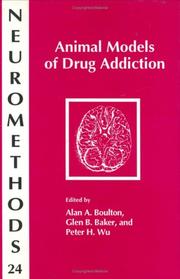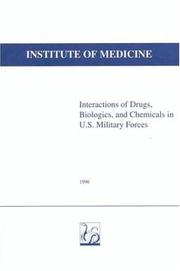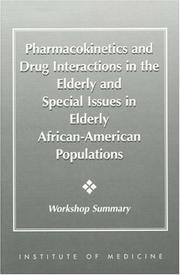| Listing 1 - 10 of 34 | << page >> |
Sort by
|
Book
ISBN: 9781437716795 1437716792 9781455737932 1455737933 1336237996 Year: 2019 Publisher: Philadelphia, Pa. : Elsevier/Saunders,
Abstract | Keywords | Export | Availability | Bookmark
 Loading...
Loading...Choose an application
- Reference Manager
- EndNote
- RefWorks (Direct export to RefWorks)
Better understand the complexities of pharmacology and physiology relevant to your practice with the brand-new medical reference book, Pharmacology and Physiology for Anesthesia. Drs. Hugh Hemmings and Talmage Egan provide the clinical insights you need to effectively administer anesthesia, ensuring patient safety and the most optimal outcomes. Consult this title on your favorite e-reader, conduct rapid searches, and adjust font sizes for optimal readability. Access comprehensive, continually updated research on the physiology of organ systems and clinical topics in the pharmacology of anesthetic drugs. Quickly and easily reference the information you need through user-friendly tables, figures, and algorithms, all presented in lavish full color throughout. Understand the molecular mechanism of drug actions and identify key drug interactions that may complicate anesthesia with dedicated sections on these key areas.
Anesthesiology. --- Anesthesia. --- Anaesthesia --- Anesthesiology --- Analgesia --- Anaesthesiology --- Surgery --- Anesthesia --- Pharmacological Processes --- Physiological Processes --- pharmacology --- physiology
Book
ISBN: 084120912X 9780841209121 Year: 1985 Volume: 277 Publisher: Washington: American chemical society,
Abstract | Keywords | Export | Availability | Bookmark
 Loading...
Loading...Choose an application
- Reference Manager
- EndNote
- RefWorks (Direct export to RefWorks)
Xenobiotics --- Metabolism --- Nutritional aspects --- Congresses --- Pharmacological Processes --- Chemicals and Drugs --- Noxae --- Food and Beverages --- Specialty Uses of Chemicals --- Physiological Processes --- Metabolic Phenomena --- Pharmacological Phenomena --- Technology, Industry, Agriculture --- Toxic Actions --- Chemical Actions and Uses --- Physiological Phenomena --- Phenomena and Processes --- Pharmaceutical Preparations --- Poisons --- Biotransformation --- Food --- Human Anatomy & Physiology --- Health & Biological Sciences --- Animal Biochemistry --- Xenobiotics - Metabolism - Nutritional aspects - Congresses
Book
ISSN: 07610211 ISBN: 9782294739217 2294739213 Year: 2013 Publisher: Issy-les-Moulineaux: Elsevier,
Abstract | Keywords | Export | Availability | Bookmark
 Loading...
Loading...Choose an application
- Reference Manager
- EndNote
- RefWorks (Direct export to RefWorks)
Vademecum indispensable à l'utilisation des médicaments et à l'exercice de la profession officinale, cet ouvrage offre une synthèse des connaissances et des compétences pharmaco-thérapeutiques selon une approche inédite : - une orientation centrée sur le médicament et les interrelations entre physiopathologie, pharmacologie et toxicologie, - une présentation didactique sous forme de tableaux permettant un accès immédiat à l'information nécessaire à la délivrance du médicament, - une lecture critique de l'ordonnance, des éléments de pharmacocinétique pratique, des fiches pharmacothérapeutiques et 20 ordonnances analysées et commentées.
Drug Therapy --- Pharmaceutical Preparations --- Counseling --- Drug Prescriptions --- administration and dosage --- Médicaments délivrés sans ordonnance --- Pharmacie --- Interactions médicamenteuses --- Pratique --- Médicaments délivrés sans ordonnance. --- Interactions médicamenteuses. --- Pratique. --- Drug Interactions. --- Drug Therapy - handbooks --- Pharmaceutical Preparations - administration and dosage --- Drug Interactions --- Nonprescription drugs --- Pharmaceutical preparations --- Pharmacological processes
Book
ISBN: 9781119599951 1119599954 Year: 2021 Publisher: Hoboken, NJ : Wiley-Blackwell,
Abstract | Keywords | Export | Availability | Bookmark
 Loading...
Loading...Choose an application
- Reference Manager
- EndNote
- RefWorks (Direct export to RefWorks)
"Lecture Notes: Clinical Pharmacology and Therapeutics provides a readable overview of all the key prescribing topics needed for medical finals and beyond. Detailed coverage and discussion of pharmacology in a clinical context combined with an accessible style mean readers can rely on the title to improve and test their understanding of pharmacological principles and reasoning throughout their time on rotation and on into foundation year. Now fully updated to include key information on Prescribing Safety Assessment, other key features of this important text include: Clinical scenarios to root each chapter firmly in a real-life setting; Prescribing points flagging up important issues of clinical relevance; Sections on drugs you may need in a hurry, prescribing and its pitfalls, and paediatric prescribing"--
Pharmacological Phenomena --- Pharmacology, Clinical --- Drug Therapy --- Phénomènes pharmacologiques et toxicologiques --- Pharmacologie clinique --- Traitement médicamenteux --- methods --- méthodes --- Chimiothérapie --- Méthodes. --- Clinical Pharmacology --- Pharmacologic Phenomena --- Pharmacologic Phenomenon --- Pharmacologic Process --- Pharmacological Concepts --- Pharmacological Phenomenon --- Pharmacologic Processes --- Pharmacological Processes --- Concept, Pharmacological --- Concepts, Pharmacological --- Pharmacological Concept --- Phenomena, Pharmacologic --- Phenomena, Pharmacological --- Phenomenon, Pharmacologic --- Phenomenon, Pharmacological --- Process, Pharmacologic --- Processes, Pharmacologic --- Processes, Pharmacological --- Pharmacological Phenomena. --- methods.
Book
Year: 2009 Publisher: [Place of publication not identified] Mary Ann Liebert
Abstract | Keywords | Export | Availability | Bookmark
 Loading...
Loading...Choose an application
- Reference Manager
- EndNote
- RefWorks (Direct export to RefWorks)
Herbs --- Drug-herb interactions --- Pharmacological Processes --- Complementary Therapies --- Publication Formats --- Pharmacological Phenomena --- Publication Characteristics --- Therapeutics --- Physiological Processes --- Physiological Phenomena --- Analytical, Diagnostic and Therapeutic Techniques and Equipment --- Phenomena and Processes --- Drug Interactions --- Phytotherapy --- Collected Works --- Health & Biological Sciences --- Pharmacy, Therapeutics, & Pharmacology --- Therapeutic use
Book
ISBN: 9780387773001 0387772995 9780387772998 9786612291821 1282291823 0387773002 Year: 2008 Publisher: New York : Arlington, VA : Springer ; AAPS Press,
Abstract | Keywords | Export | Availability | Bookmark
 Loading...
Loading...Choose an application
- Reference Manager
- EndNote
- RefWorks (Direct export to RefWorks)
I have always been interested in chemistry and biology. My undergraduate, graduate, and postdoctoral trainings in pharmacy, medicinal chemistry and pharmacology, respectively, have strengthened this interest and led me to realize that significant advances in medicine have frequently been realized because of research at the chem- try–biology interface. I am hoping that this comprehensive volume on recent advances in bioactivation research will stimulate pharmacologists, medicinal chemists, phar- ceutical scientists, and graduate students in these fields and related areas to consider and use bioactivation research when they explore and chart new frontiers in drug design and drug development and when they consider ways to reduce the side effects of existing drugs by making prodrugs. As for the toxicologists and environmental health scientists, I hope this volume will help them generate the knowledge needed to understand better mechanisms of toxicity to improve human risk assessments and intervention methods after occupational or environmental exposure to various hazardous chemicals. Adnan A. Elfarra, Ph. D. vii Part I General Concepts and Basic Mechanisms 1 Metabolic Concerns in Drug Design Jeffrey P. Jones Department of Chemistry, Washington State University, Pullman, WA 99164, USA e-mail: jpj@wsu. edu Keywords: Cytochrome P450 Aldehyde Oxidase Drug–Drug Interactions Mechanism-based Virtual Screening ADMET Regioselectivity 1. 1. Introduction Due to recent technological innovations, such as genomics, combinatorial chemistry, and high-throughput screening, the identification of disease targets and of compounds that are active against these targets (‘‘leads’’) can now be carried out efficiently.
Biomedicine. --- Pharmacology/Toxicology. --- Immunology. --- Medicine. --- Toxicology. --- Médecine --- Immunologie --- Toxicologie --- Biotransformation (Metabolism). --- Biotransformation. --- Drug activation. --- Biotransformation (Metabolism) --- Drug activation --- Pharmacological Processes --- Metabolism --- Metabolic Phenomena --- Pharmacological Phenomena --- Physiological Processes --- Physiological Phenomena --- Phenomena and Processes --- Biotransformation --- Human Anatomy & Physiology --- Health & Biological Sciences --- Animal Biochemistry --- Activation, Metabolic --- Bioactivation (Metabolism) --- Biodegradation (Metabolism) --- Metabolic activation --- Activation of drugs --- Drugs --- Activation --- Pharmacology. --- Pharmacology --- Immunobiology --- Life sciences --- Serology --- Chemicals --- Medicine --- Poisoning --- Poisons --- Toxicology --- Drug effects --- Medical pharmacology --- Medical sciences --- Chemotherapy --- Pharmacy --- Physiological effect

ISBN: 0896032175 1592596290 Year: 1992 Volume: 24 Publisher: Totowa, N.J. : Humana Press,
Abstract | Keywords | Export | Availability | Bookmark
 Loading...
Loading...Choose an application
- Reference Manager
- EndNote
- RefWorks (Direct export to RefWorks)
to the Animal Models Volumes This volume describes animal models of drug addiction. Because of increasing public concern over the ethical treatment of animals in research, we felt it incumbent upon us to include this general preface in order to indicate why we think further research using animals is necessary. Animals should only be used when suitable alternatives are not available, and humans can only be experimented upon in severely proscribed circumstances. Alternative procedures using cell or tissue culture are inadequate in any models requiring assessments of behavioral change or of complex in vivo p- cesses. However, when the distress, discomfort, or pain to the animals outweighs the anticipated gains for human welfare, the research is not ethical and should not be carried out. It is imperative that each individual researcher examine his/ her own research from a critical moral standpoint before eng- ing in it, and take into consideration the animals’ welfare as well as the anticipated gains. Furthermore, once a decision to p- ceed with research is made, it is the researcher’s responsibility to ensure that the animals’ welfare is of prime concern in terms of appropriate housing, feeding, and maximum reduction of any uncomfortable or distressing effects of the experimental conditions.
Alcoholism --- Drug abuse --- Alcohol, Ethyl --- Disease Models, Animal --- Drug Tolerance --- Models, Genetic --- Substance Dependence --- Animal models --- pharmacology --- physiopathology --- Ethanol --- Substance-Related Disorders --- Pharmacology --- Models, Biological --- Alcohols --- Mental Disorders --- Animal Diseases --- Diseases --- Models, Animal --- Pharmacological Processes --- Biological Science Disciplines --- Organic Chemicals --- Physiological Processes --- Investigative Techniques --- Natural Science Disciplines --- Models, Theoretical --- Pharmacological Phenomena --- Psychiatry and Psychology --- Physiological Phenomena --- Chemicals and Drugs --- Disciplines and Occupations --- Analytical, Diagnostic and Therapeutic Techniques and Equipment --- Phenomena and Processes --- Substance Abuse Disorders --- Psychiatry --- Health & Biological Sciences --- pharmacology. --- physiopathology. --- Models, Genetic. --- Animal models. --- Disease Models, Animal. --- Drug Tolerance. --- Neurosciences. --- Psychiatry. --- Medicine and psychology --- Mental health --- Psychology, Pathological --- Neural sciences --- Neurological sciences --- Neuroscience --- Medical sciences --- Nervous system
Book
ISBN: 1617792128 9786613354068 1283354063 1617792136 9781283354066 9781617792137 Year: 2011 Publisher: New York : Humana Press/Springer,
Abstract | Keywords | Export | Availability | Bookmark
 Loading...
Loading...Choose an application
- Reference Manager
- EndNote
- RefWorks (Direct export to RefWorks)
The revised and up-to-date third edition of Drug Interactions in Infectious Diseases delivers a text that will enhance your clinical knowledge of the complex mechanisms, risks, and consequences of drug interactions associated with antimicrobials, infection, and inflammation. The third edition features five new chapters that cover material not addressed in previous editions. These new chapters describe interactions with a number of drug classes such as non-HIV antiviral, antimalarial, antiparasitic, antihelmintic, macrolide, azalide and ketolide agents. A novel chapter on probe cocktail studies has been included to highlight an important research tool for drug development. These chapters address material that cannot be retrieved easily in the medical literature. The highly acclaimed food-drug interactions as well as the study design and analysis chapters remain definitive references. The newly written drug-cytokine interaction highlights the need for our improved understanding of the complex interrelationship of acute infection, inflammation, and the risk of drug interactions. Informative tables on specific drug-drug interactions are provided throughout the chapters as a quick clinical resource. The Third Edition of Drug Interactions in Infectious Diseases is a distillation of relevant drug interactions associated with antimicrobials, infection, and inflammation. This concise review of the mechanisms and strategies to manage drug interactions should be valuable to all health care practitioners. Features · Definitive reference source of up-to-date information on antimicrobial drug interactions · Informative tables on the degree of interaction for specific antimicrobial agents · In-depth discussion of mechanisms and potential mechanistic pathways of interaction · New chapters on non-HIV antiviral, antimalarial, antiparasitic, and macrolide, azalide and ketolide agents · New chapter on probe-cocktail studies as a research tool to study drug-drug interactions · Inclusion of new antimicrobial agents and their associated drug interactions · First rate chapters on study design and analysis, and drug-food interactions · A fresh perspective on drug-cytokine interactions · Authoritative chapter on regulatory considerationsof drug interactions during drug development · Inclusion of new antimicrobial agents and their associated drug interactions.
Anti-infective agents -- Side effects. --- Drug interactions. --- Anti-infective agents --- Drug interactions --- Pharmacological Processes --- Therapeutic Uses --- Physiological Processes --- Pharmacological Phenomena --- Pharmacologic Actions --- Chemical Actions and Uses --- Physiological Phenomena --- Chemicals and Drugs --- Phenomena and Processes --- Anti-Infective Agents --- Drug Interactions --- Health & Biological Sciences --- Medicine --- Pharmacy, Therapeutics, & Pharmacology --- Infectious Diseases --- Side effects --- Side effects. --- Interactions, Drug --- Pharmacy. --- Medicine. --- Pharmaceutical technology. --- Infectious diseases. --- Medicine & Public Health. --- Infectious Diseases. --- Pharmaceutical Sciences/Technology. --- Drugs --- Emerging infectious diseases. --- Chemistry --- Materia medica --- Pharmacology --- Emerging infections --- New infectious diseases --- Re-emerging infectious diseases --- Reemerging infectious diseases --- Communicable diseases --- Pharmaceutical laboratory techniques --- Pharmaceutical laboratory technology --- Technology, Pharmaceutical --- Technology

ISBN: 0309055938 9786610192076 1280192070 030956204X 9780309562041 9780309055932 Year: 1996 Publisher: Washington, D.C. : National Academy Press,
Abstract | Keywords | Export | Availability | Bookmark
 Loading...
Loading...Choose an application
- Reference Manager
- EndNote
- RefWorks (Direct export to RefWorks)
TECHNOLOGY & ENGINEERING --- Military Science --- Medicine, Military --- Drug interactions --- Drug utilization --- Pharmacological Processes --- Drug Information Services --- Occupational Groups --- Environmental Pollutants --- Product Surveillance, Postmarketing --- Biological Products --- Evaluation Studies as Topic --- Complex Mixtures --- Persons --- Pharmacological Phenomena --- Toxic Actions --- Information Services --- Pharmaceutical Services --- Physiological Processes --- Health Services --- Chemicals and Drugs --- Chemical Actions and Uses --- Investigative Techniques --- Physiological Phenomena --- Information Science --- Named Groups --- Phenomena and Processes --- Health Care Facilities, Manpower, and Services --- Analytical, Diagnostic and Therapeutic Techniques and Equipment --- Health Care --- Adverse Drug Reaction Reporting Systems --- Drug Interactions --- Military Personnel --- Hazardous Substances --- Vaccines --- Medicine --- Health & Biological Sciences --- Military & Naval Medicine --- Evaluation --- Drug interactions. --- Evaluation. --- Interactions, Drug --- Drugs --- Side effects

ISBN: 0309058929 9786610187126 1280187123 0309562341 9780309562348 9780309058926 030917452X Year: 1997 Publisher: Washington, D.C. : National Academy Press,
Abstract | Keywords | Export | Availability | Bookmark
 Loading...
Loading...Choose an application
- Reference Manager
- EndNote
- RefWorks (Direct export to RefWorks)
Geriatric pharmacology --- Drug interactions --- Pharmacokinetics --- Older African Americans --- Adult --- African Continental Ancestry Group --- Kinetics --- Pharmacological Processes --- Pharmacological Phenomena --- Therapeutics --- Ethnic Groups --- Phenomena and Processes --- Biochemical Phenomena --- Population Groups --- Analytical, Diagnostic and Therapeutic Techniques and Equipment --- Age Groups --- Physiological Processes --- Continental Population Groups --- Persons --- Chemical Phenomena --- Named Groups --- Drug Therapy --- African Americans --- Drug Interactions --- Aged --- Medicine --- Health & Biological Sciences --- Geriatrics --- Age factors --- Medical care --- Drug use --- Geriatric pharmacology. --- Drug interactions. --- Age factors. --- Medical care. --- Drug use. --- African American aged --- African American older people --- Afro-American aged --- Older people, African American --- Age factors in pharmacokinetics --- Interactions, Drug --- Older people --- Aging --- Drugs --- Pharmacology --- Side effects
| Listing 1 - 10 of 34 | << page >> |
Sort by
|

 Search
Search Feedback
Feedback About UniCat
About UniCat  Help
Help News
News